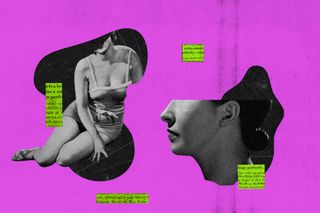
The Feminist Debate: Is Being Objectified Disempowering?
The feminist debate on being objectified isn’t settled yet — sometimes, consensual sexual agency can’t be separated from objectification.

In Feminist Debates, we pit feminist arguments about power, sex, work, and love against each other — and unpack the grey areas.
Many former Playboy Bunnies have recently begun speaking up about their ordeal with Hugh Hefner, the late magazine magnate who built the Playboy empire. Playboy, as an institution, almost single-handedly derailed feminist political organizing: as a product of the free love generation, it masqueraded as empowering amid the puritanical moral panic against women’s sexuality. Here is right around where a word started gaining currency: objectification. It was used by feminists to describe a state of being reduced to a body, a commodity, to be consumed by men for sexual pleasure. Playboy exemplified it with its nude photoshoots, and Hefner created the “hourglass” silhouette that, in Gloria Steinem’s words, made Bunnies the “most envied girls in America.” But how can a state of being perceived be simultaneously enviable and oppressive?
The debate around objectification continues to date, but it’s complicated. There’s another figure in pop culture history, however, who is remembered for simultaneously being a victim of media objectification, and subverting it: Marilyn Monroe. The recent biopic about her, Blonde, received backlash for its voyeuristic portrayal of Monroe through the male director’s lascivious gaze. But Monroe herself owned her sexuality, her image, and her body in ways that make it hard to slot her into the “helplessly objectified” category. It’s possible, clearly, to have agency while being objectified. So is it really that disempowering at all?
Yes, because objectification reduces women to their bodies
The radical feminist Andrea Dworkin said, “It is true, and very much to the point, that women are objects, commodities, some deemed more expensive than others — but it is only by asserting one’s humanness every time, in all situations, that one becomes someone as opposed to something.” This is the common understanding of what it means to be objectified — to be reduced to something not human. Resisting objectification is essential to feminism because it’s nothing short of reclaiming humanity.
Moreover, there’s a difference between being sexual and being sexy: the former is intentional; the latter strips a person of their agency. Subsequently, researchers found that objectification within relationships leads to sexual coercion and pressure, too. It’s a conversation that’s picked up steam in the age of hook-up culture and dating apps: where success is determined by the ability to objectify oneself for someone else’s pleasure. Feminists have begun critiquing the empowerment narrative woven around the culture — taking the conversation back to where it began: optimizing oneself for an external (usually male) gaze takes away our agency as women — and as feminists.
The flipside: having one’s body desired isn’t always demeaning
“Even the most ardent feminist sometimes wants to feel physically appreciated and desired in a way that is separate from her other qualities,” The Cut noted. And philosophers say that sexual desire is inseparable from objectification. But it’s not necessarily a bad thing — it may, in fact, be the only way to engage in mutually reciprocal desire. Besides, many women have begun to experience being desired as empowering — and there’s a fuzzy boundary between where desire ends and objectification begins. Often, they can be the same thing. Take the fact that a line delivered by Anthony in season two of Bridgerton entered the period drama swoon-worthy dialogue hall of fame: “You are the bane of my existence, and the object of all my desires.”
Moreover, people are, objectively, objects. They occupy space, they exist in the physical dimension. Some feminists suggest that acknowledging — and acting on — this fact by expressing a desire for someone isn’t inherently a bad thing. In fact, it’s a good, positive thing. It’s only bad when someone is treated only as an object and nothing else. “[W]e must treat others as instruments, for we need their skills, their company, and their bodies — in fact, there is little that we social creatures can do on our own, and so little that is fulfilling,” writesLeslie Green. It’s why we take joy and pleasure out of being physically pleasing to a partner — because their response goes beyond impersonal objectification. It can be intimate and empowering all at once.
*
Being objectified is damaging because it makes you internalize someone else’s gaze
Feminist theory has argued that pervasive objectification by the media, society, and institutions leads women to self-objectify. This means that they perceive themselves as objects, and base their own self-worth on how they appear to others. This, in turn, leads to mental health risks that affect women disproportionately — and we’ve seen this happen with the rise of eating disorders. It’s an old theory, but it still applies — arguably, social media platforms like Instagram fuel the cycle of self-objectification to a much higher degree than ever, and it’s unsurprisingly also correlated with the rise of eating disorders, negative body image, anxiety issues, and unhealthy perceptions of sex and desire among young girls and women. The model Emily Ratajkowski noted what it’s like to define one’s entire self-based on the male gaze: in her essay Buying Myself Back, she described the struggle to regain ownership over her own body, once its image became commodified and saleable by others.
The flipside: self-objectification can be empowering for people who’ve been excluded from beauty
Instagram is also a space for redefining beauty standards. There’s nothing inherently demeaning in actively making an effort to be sensually and aesthetically pleasing, according to Janet Richards. And in a culture where patriarchal beauty norms intersect with desirability, subverting said norms by asserting desirability anyway can be feminist resistance. Put simply: showing off our bodies for sexual pleasure can be a way of showing that desire is complex, and can’t be contained in exclusionary body types alone.
In fact, consider that being subjectified may actually be the more disempowering thing. It’s the experience of the old, the fat, the disabled, or the otherwise marginalized who are not deemed to be of any use to society because of their physical attributes. “[T]hey miss not only their diminished agency, but also their diminished objectivity. … They become … subjectified,” Green notes. To reclaim objectification from these positions, then, is to actually humanize oneself. See also: Lizzo twerking while playing James Madison’s flute.
*
Objectification perpetuates rape myths
The debate around “item songs” is as old as the phenomenon itself. Cabaret dancing traditions evolving into raunchy dance numbers in films have created a stir: often, lyrics erase the dancing woman’s agency, and the setting features leering, jeering men who consume the woman’s body with their eyes. Even pop music videos have been implicated — as forms of mass media, they’re responsible for convincing generations of young women that the only way to be desired is to submit their bodies to a gaze. Often, it’s the male gaze, and images like these percolate into society’s consciousness to perpetuate the idea that women who dance, show some skin, or express sexual desire are fair game — as sexual objects inviting sexual attention, their consent is immaterial. In fact, rape culture depends heavily on perpetuating the notion that women are objects. Research has found that sexual objectification increases victim blaming and decreases the perception of harm among survivors. During #MeToo, many women in film industries across the world were similarly dismissed: as people who consented to be objectified before millions, they were seen to be “asking for it.”
The flipside: rape myths make objectification a bad thing
As Cary Tennis put it to a reader who liked being objectified in bed: “This activity that you enjoy might have many meanings and purposes. It may be a form of play in which you embody your own powerlessness and thus deflate it. It may be a way of doing what you fear most in order to get over the fear. It may just get you hot.” Objectification isn’t mutually exclusive with consent, love, or respect — and feminists have noted that they can all co-exist.
Plus, there’s a big difference between being seen as an object, and being treated as one. Feminist thinkers like Martha Nussbaum have highlighted that difference: “[T]he term objectification can also be used… in a more positive spirit. Seeing this will require … seeing how the allegedly impossible combination between (a form of) objectification and equality, respect, and consent might, after all, be possible,” Nussbaum wrote.
When we see objectification as a bad thing, then, it’s because rape culture tells us that bodies are things to be used, and are inherently separate from minds, which are the sites of agency. But bodies and minds aren’t a binary: and yet, the socially constructed binary helps rape myths because of how it can easily divorce consent from bodies.
To say that being objectified is always disempowering, then, could play into the same binary that helps prop up another harmful belief system. It’s not as much of a settled debate as it seems.
Rohitha Naraharisetty is a Senior Associate Editor at The Swaddle. She writes about the intersection of gender, caste, social movements, and pop culture. She can be found on Instagram at @rohitha_97 or on Twitter at @romimacaronii.
Related


The Buzz Cut: Couple Releases New Documentary Spotlighting How They Left the Spotlight
